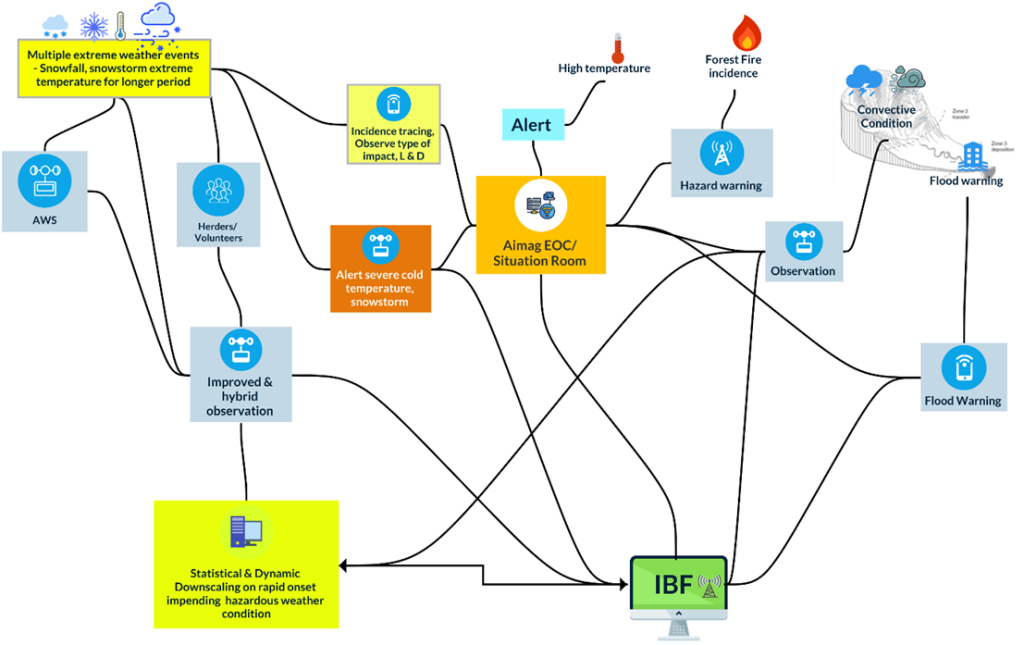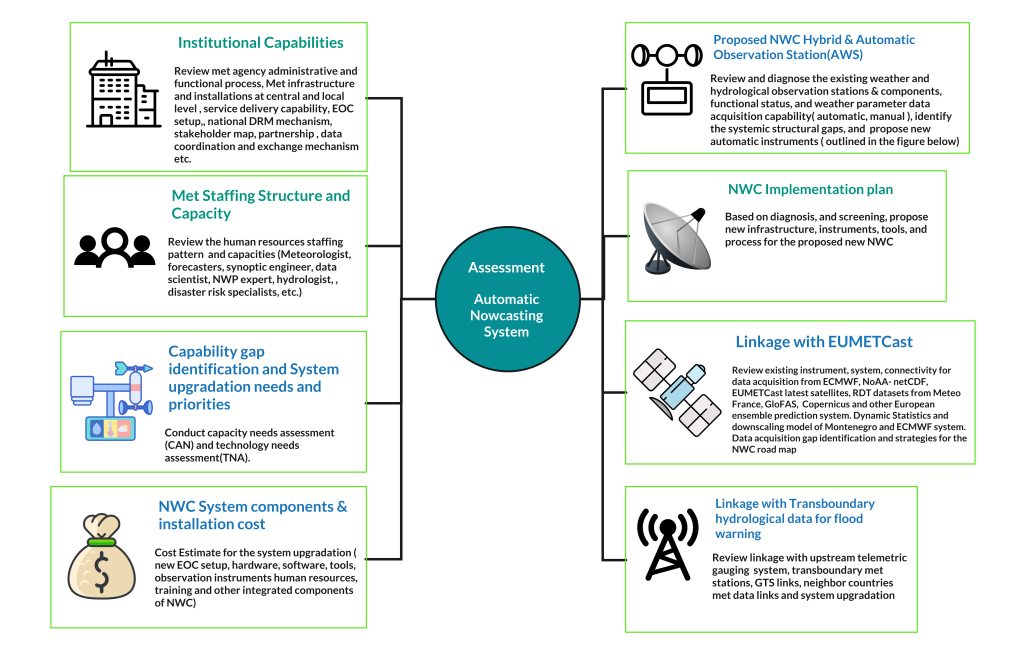The Multi-hazard Early Warning Center (MHEWC) has the capacity to install the least-cost and easily maintainable nowcasting services with the interpretation of the status of (up-to-date time-series datasets) weather parameter updates instantly being captured by the met stations.
8.2. Process of developing an Early Warning (Sample case of Mongolia) :
Reviewing the above(figure 19) multi-hazard incidence and stressed timespan likely to be impending, it is quite obvious that Mongolia essentially needs to make the paradigm shift from a traditional forecast to the most updated multi-hazard(s) early warning system, real-time alerting to inform frontline most climate vulnerable herder, farmer, and living community.
The robust implementation of integrated impact forecasting & multi-hazard early warning is the substantive solution to the Mongolian unstable hazardous weather prediction. Typically, the IBF system is integrated with an autonomous and ICT-driven automatic multi-hazard warning process.
Anchoring impact forecast is the first step of the process initiating with a certain lead-time span, and afterward the 2nd step to putting strong hybrid observation( figure 9) of ongoing/prevailing weather conditions to screen carefully over the likelihood of turning to multi-hazards. Following the prevailing critical weather conditions being screened/observed at real-time and spatiotemporal scale, now prepare emergency hazard warnings and advisories to inform the humanitarian program cycle about the level of response that needs to be mobilizing. Over the 3rd step process, the IBF system needs to trigger early warning programmatically (IT) plotting over the map where loss & damages ( L & D) are taking place and placemark of the other hotspot where potential L & D can take place, subsequently to provide advisory on undertaking early actions & contingencies and mobilizing humanitarian response based on forecasts & warnings. However, the most important duty of the IBF system is to provide timely forecasts and warnings for saving lives and properties when the situation is intensifying to sudden onset and rapidly developing weather conditions are likely to impend convective rain and potentiality to trigger flash flooding to cause L & D of lives and properties, in this case, common alerting and warning essentially need to deploy. Since weather events are sudden onset the CAP & warning has to be automatically operational with IT programs ( CAP programme with python, JAVA scripts ) and using other tools e.g. Google public alerts other sub-set of process.

Figure 22 : Nowcasting, hourly, daily IBF production process and issuing a multi-hazard early warning :
8.3 The multi-hazard early warning process:
- Improving nowcasting to hourly IBF on hazardous weather phenomena :
For the complete document, please contact the author ……………………………………
Montenegro Assessment – Technical Proposal
Developing the RoadMap for the development of the National Nowcasting (NWC) System for the Institute for Hydrometeorology and Seismology of Montenegro (Technical Proposal conducting the Assessment)
- Introduction:
Montenegro is highly vulnerable to hydrometrical hazards e.g., in intensity of floods, flash floods heavy rainfall, snowfall, windstorms, heatwaves, avalanches, forest fires, droughts, storms, landslides, and rock falls, etc., potentially causing loss and damage to lives, livelihoods and asserts. At the outset, the heavy rainfall frequency and intensity increased with the changing climate patterns of the world. With the given phenomenon Montenegro essentially needs a robust integrated nowcasting, weather waning, multi-hazard early warning, disaster alerting, and impact-based weather forecasting system for making the country well prepared for the impeding multi-hazards.
2.0 The technical approach and methodology for developing the road map of the NWC system.
Developing the detailed road map for establishing the National Nowcasting (NWC) robust system, the consultant intended to devise in such a way that the infrastructure and operationality can robustly be capable of tracking weather events with the hybrid system, manufacturing forecast warnings, alerts of impending as multi-hazards at a precision level so that elements and sectors are well informed. The design outline contextualizes the complete mechanism of designing, implementing, and operationalizing (one-stop solution) procedure of the system, coordination and partnership, standard operating procedure (SOP), and enabling institutional capacity for running the state-of-the-art integrated nowcasting service being mandated by the Institute for Hydrometeorology and Seismology of Montenegro of Montenegro (ZHMS). Review the following components, gap identification, and strategy development for a roadmap.

- Strategic methodology for diagnosing/screening of existing system, structure and process, efficiency, and efficacy:
- Conduct desk review:
- Review of Hydro-meteorological forecasting product, outlook, warning and alerting services,
- Review Numerical weather prediction (NWP) system over the long, medium, and short-range forecasting products.
- Review the existing forecasting capabilities, modeling, ensemble system, and short-range forecasting process and capacities, ECMWF Montenegro, Balkan Region weather forecast,
- Review the sector specific operational forecasting (dynamic statistical and downscaling model for predicting rapidly developing weather conditions) products and services.
- Review reports on the hydrological situation, warnings and forecasts produced by the Institute of Hydrometeorology and Review Damage and Loss assessment tools.
- Review hydrometeorological observations/monitoring systems are in place, data acquisition, collation, management systems and networks and data exchange, preparing multi-hazard analysis and mapping to support risk assessment, multi-hazard Early warning systems.
- Review reports on national climate multi-hazard risk and vulnerability assessment (CRVA), country risk profile
- Review all relevant technical reports, strategies, studies, research and development on extreme weather events(frequency, intensity, landing pattern, trends and future threats, loss and damage category and statistics), multi-hazards and early warning mechanisms of Montenegro.
- Review Weather observation System (tools, technologies, instruments, data acquisition etc.):
- Diagnose the complete forecasting system, mechanism, weather observation system (number of automatic, telemetric and manual), geolocation of weather observation system, spatial observation station gaps, number of river gauging stations, number of telemetric stations over the river system for tracking the synoptic conditions of the surface weather system.
- Review the clusters of observation technologies are currently being deployed, supercomputers, European Weather Clouds (NWC), limited area numerical models are being used, European ensemble prediction system( ECMWF, GFS, UKMO, Meteo France, etc.) , data analysis, reanalysis, bias-correction, ensemble model prediction, meteorological radars are deployed, drone radar technology, access to latest EUMETCast satellite data system , and other relevant tools
- Review the institutional data sharing bottlenecks, and access limitation to radar data from neighboring countries and gap identification.
| Target audience/stakeholders | Consultation process | Expected outcome |
| Conduct in-depth interviews (Key Informant Interviews – KII) with key stakeholders/sectors (Government national and sub-national entities) & state, non-state actors, vulnerable communities, community leaders, and another special group(indigenous), educational institutes, Women affairs organizations. Focus Group Discussions (FGDs) with key stakeholders & vulnerable communities. FGD & KII with CSO, CBO, development partners, I/NGOs, charities, women-led groups, commercial stakeholders, market promoters, and other relevant enterprises/actors/entities | FGD & KII | What is the current level of weather warning of services are delivering and difficulties are experiencing accessing weather warning. Type of information and informed tools are essentially required. |
- Review the existing surface weather parameters (index, indices) and multi-hazards observation system /instrument for rapidly development weather conditions across the country :
- Review the components of tracking weather parameters, number of automatic instrument, instrument for detecting convective weather conditions, thunderstorm, CAPE, trough , lightning and rapidly developing thunderstorms (RDT) developed by Meteo France , EUMetcast, NOAA etc.
- Review the national weather warning and alerting system and comprehensively diagnose observation mechanism, the system structure, capability and performance for robust warning systems.
- Review the current functionality of 51 hydrological stations (31 in Black Sea basin24 and 20 in Adriatic Sea basin) of which 31 are automatic and connected with the Centre in Podgorica. Gap identification over surface observation mechanism, overall observations, and strategy development for new road map. Review the level of hybrid observations system and identify the system efficiency and efficacy.
- Review data collection tools, data collection, assimilation and gap identification of sudden-onset extreme weather system :
Improved nowcasting services depends on highest density of surface hydrological information, multi-hazards are impending and takes landfall, hazard incidence and hotspot tracking (heavy rainfall, convective thunderstorm, hailstorm, high-winds, flashfloods, and landslide etc.). Complying with the robust system, the Surface level hybrid observations essentially and timely be able to capture event situation and hotspots to feeding in nowcasting system. For upgrading to robust alerting for sectors, elements, and livelihoods, following screenings are essentially to be conducted.
- Review data collection mechanism of ZHMS, Hydrometeorological Institute of Montenegro
- Review multi-hazard data collection, collation and GIS based multi-hazard interpretations by the Hydrometeorological Institute of Montenegro and other relevant departments.
- Review mechanism of data is collected through meteorological, hydrological and agrometeorological measurements, which monitor weather, water, and air, and that are maintained by ZHMS.
- Review the framework and networking of flood forecasting system, real-time hydrometeorological data acquisition and access, most urgent flash flood prediction system, how they are accessing heavy rainfall data from AWS, measuring the extent of rainfall catchment areas, extent of basin , running flood model, providing flood forecasting and early warning, flood alerting to community and local level high-value installations and elements ( assets and economical) .
- Review the limitation of ZHMS in the forecasting of floods /flash floods, GIS programs for automatic hazard monitoring.
- Conduct consultation with organizations, Gap identification over the capacity needs and technology needs.
- Organize consultation with climate, hydrological, hydrographic, environmental and agrometeorological research institutes, National hydrometeorological services( NHMS) organizations, relevant organizations, institutions and agencies, academia; Directorate for Emergency Situations under the Ministry of Interior;, Institute for Hydrometeorology and Seismology of Montenegro (ZHMS), under the Ministry of Sustainable Development and Tourism; Ministry of Rural Development and Agriculture; Directorate for Water, under the Ministry of Rural development and Agriculture; Forestry Directorate, under the Ministry of Rural development and Agriculture; Local Authorities – Secretariats involved in water management, Ministry of Interior, Ministry of Defense; Ministry of Agriculture and Rural Development; Ministry of Sustainable Development and Tourism; Ministry of Health, Ministry of Science; Institute of Hydrometeorology and Seismology, Institute for Emergency Medical Services; Institute of Public Health, Red Cross of Montenegro, Agency for environmental protection and Center for eco-toxicological tests. Deputy Minister of Agriculture and Rural Development – Department of Water Management; The Ministry of Agriculture and Rural Development, the Institute for Hydrometeorology and Seismology of Montenegro and the Ministry of Interior ; The Ministry of Agriculture and Rural Development (MARD) is in charge of water management Water Directorate (WD).
- Review the transboundary hydrological datasets for implementation of the European Union Water Framework Directive (WFD) and the Floods Directive.
- Review the capacity of Directorate for Emergency Situations about data acquisition, collation and processing capacity .
- Conduct site visits :
| Target locations | Site visits | Outcome |
| Site visits to high risk areas(flash flooding , landslide) and identify the causal relations of intensity and frequency of hydrometeorological extreme weather events, landscape , geographical settings, morphological characteristics, multi-hazard exposure, risk and vulnerability | Highly vulnerable areas Hydrometeorological stations and locations | Identify what type of instruments, technology , system and services are required for the robust NWC system |
- Organize national workshop /meeting with stakeholders opinion sharing and recommendations:
| Target audience/stakeholders | Consultation process | Expected outcome |
| Conduct in-depth interviews (Key Informant Interviews – KII) with key stakeholders/sectors (Government national and sub-national entities) & state, non-state actors, vulnerable communities, community leaders, and another special group ( indigenous), educational institutes, Women affairs organizations. Focus Group Discussions (FGDs) with key stakeholders & vulnerable communities. FGD & KII with CSO, CBO, development partners, I/NGOs, charities, women-led groups, commercial stakeholders, market promoters, and other relevant enterprises/actors/entities | FGD & KII |
- Review the study findings and propose Dynamic Plan for Implementation of NWC system.
- Based on comprehensive studies/consultation, recommendations etc., prepare road map of overall system architecture, design, the item-wise instruments, tools, hardware, software for upgrading real-time weather and multi-hazard observations and develop road map of new NWC system.
- Organize lessons learning meetings/workshop, capturing recommendations and prepare Final report
- Propose detailed cost estimation of Implementation of NWC system
Prepare detailed upgradation plan, budget, item-wise cost estimation of the instruments, hardware, software, installations, capacity building of the human resources etc.